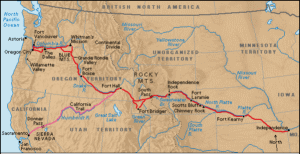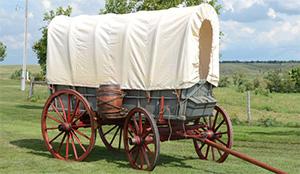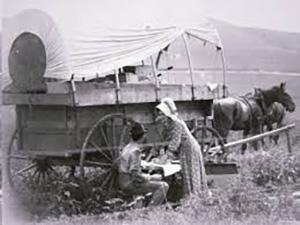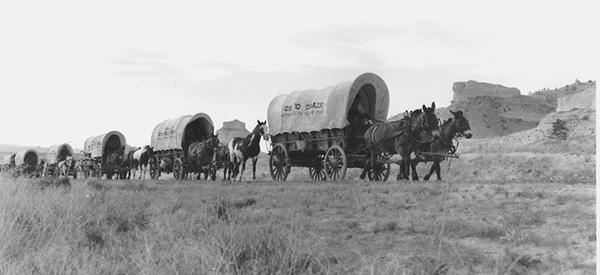The Oregon Trail has a legendary place in the history of the United States. Originally built by fur traders and trappers in the early 19th century, by the mid-1840s it had become one of the most important routes for settlers moving out West. By the time the first transcontinental railroad opened in 1869 and use of the trail started to decline about 400,000 people had set out along it to build a new life on the frontier.
 Taking the trail wasn’t like setting out on a modern highway, though. From its beginning on the Missouri River to the end in Oregon City the trail covered almost 2,200 miles, and a lot of it was rough country. The Trail passed through mountains, forests and arid plains. In some places lack of water was a danger; in others there were dangerous rivers to be crossed. Disease, wild animals and Indian attacks were constant threats. Migrants set out in early summer and aimed to reach Oregon before winter arrived, but early snowstorms in the mountains brought the risks of avalanches and hypothermia. At least 10,000 people, and possibly as many as 21,000, died along the Trail – up to five percent of those who set out along it.
Taking the trail wasn’t like setting out on a modern highway, though. From its beginning on the Missouri River to the end in Oregon City the trail covered almost 2,200 miles, and a lot of it was rough country. The Trail passed through mountains, forests and arid plains. In some places lack of water was a danger; in others there were dangerous rivers to be crossed. Disease, wild animals and Indian attacks were constant threats. Migrants set out in early summer and aimed to reach Oregon before winter arrived, but early snowstorms in the mountains brought the risks of avalanches and hypothermia. At least 10,000 people, and possibly as many as 21,000, died along the Trail – up to five percent of those who set out along it.
In fact, considering how dangerous the Trail really was, what’s remarkable is that 95% of the pioneers who headed west along it didn’t die. They were tough people, of course. To set out on a journey like that you had to be determined, and they weren’t going to give up and die at the first obstacle. They were also prepared people, though. They knew the dangers they would face, and they carried the best equipment they had to deal with them along the way.
The settlers weren’t just carrying the 19th century equivalent of a bug-out bag or survival kit; they had everything they needed to survive the Trail and build a new life at the end of it. Most people who took the Trail had at least one wagon with them and sometimes two or even more.
 Nicknamed “prairie schooners”, the wagons were usually twelve feet long and six wide, and could carry over a ton of supplies. They had high sides, waterproofed with tar so the wagon could be pulled through streams and rivers without flooding. A well-proofed wagon, even fully loaded, could float if deeper water had to be crossed. The canvas canopies were oiled to keep the rain out. Each wagon was pulled by a team of eight to twelve oxen; these were slower than horses, but they could graze on the rough vegetation along the route.
Nicknamed “prairie schooners”, the wagons were usually twelve feet long and six wide, and could carry over a ton of supplies. They had high sides, waterproofed with tar so the wagon could be pulled through streams and rivers without flooding. A well-proofed wagon, even fully loaded, could float if deeper water had to be crossed. The canvas canopies were oiled to keep the rain out. Each wagon was pulled by a team of eight to twelve oxen; these were slower than horses, but they could graze on the rough vegetation along the route.
In movies the settlers themselves often ride in the wagons. In reality, they walked alongside; space in the wagons was needed for their essential equipment. Here’s some of what they carried:
#1. Pioneer’s Wagon Diet
Settlers would hunt and forage along the way, but if they wanted to reach Oregon before winter arrived they had limited time for that – and, as the numbers using the Trail increased, there was less food to be found anyway. The core of a settler’s diet was what they carried with them, and that had to be energy-dense food that traveled well. The usual ration per person was 200 pounds of flour, 150 pounds of bacon, 80 pounds of lard, 20 pounds of sugar and ten pounds each of coffee and salt. Bacon was packed in barrels of bran to insulate it. Eggs were also carried, packed in cornmeal – as the eggs were eaten the meal could be turned into cornbread.
Many settlers brought a small herd of beef cattle with them, for slaughter along the Trail. Even more had a milk cow. They made butter along the way; each morning creamy milk was put in covered buckets that were hung under the wagon. The bumping of the unsprung chassis churned it, and when they stopped for the night the fresh butter could be skimmed off.
Related: How To Make Ash Cakes; The Ultimate Pioneer Food
#2. Pioneer Defenders
Almost nobody headed out west without at least one gun. A rifle or shotgun was the most common choice, because its main uses were hunting and protection against wild animals. Guns were also needed for defense against Indian raids. These weren’t as common as you might think from the movies, but they did happen – between 1840 and 1860 an average of twenty settlers a year were killed by Indians. Again, a rifle was the best choice; Indians could attack with bows and arrows from far outside effective handgun range.
#3. Dutch ovens
Many different cooking utensils were carried, but the Dutch oven was the main one. It could be used for cooking oatmeal, stews, soup or bread. The lid worked as a skillet. Nothing beats a Dutch oven for versatility, and being able to load it on a wagon made its weight irrelevant.
#4. Water keg
There was no way the average settler could carry enough water to make the whole trip without resupply. That meant they had to collect water along the way. For most of the route there were plenty supplies close to the Trail, but there were also drier stretches. Stopping to collect water during the day also wasted time, so each wagon had at least one water keg. It would be refilled every time the settlers found a source of fresh water, and that meant there was always water available in the wagon.
#5. Chopping Tools
Most settlers carried at least two chopping tools. An ax could be used to fell trees and split firewood; a hatchet worked for smaller jobs around camp, as a wedge for splitting logs, and even as a last-ditch weapon. Being able to cut timber was essential; wagon repairs, corduroy for tough sections of trail, and building shelters all needed wood.
 #6. Pioneer’s Medical Chest
#6. Pioneer’s Medical Chest
Minor injuries were common along the Trail, and most wagons had a medical chest to deal with them. Bandages, ointments and patent medicines covered most problems.
Related: The Lost Pioneer Flu Shot
#7. Surgical instruments
The idea of carrying out surgery on a family member – or yourself – is pretty horrific to us, but on the Trail there was sometimes no alternative. It could be along way between forts and settlements, and often the choice was treat it yourself or suffer. Many settlers had the instruments needed to extract a tooth, suture a wound or lance a boil. Some also had the tools to extract a bullet or arrowhead, and even amputate a limb. Alcohol or opium were used as painkillers.
#8. Pioneer’s Repairing Tools
A broken wagon that couldn’t be repaired might easily be a death sentence on the Trail. In later stages there might be room on someone else’s wagon to load your food and maybe some other supplies, but if anyone had to abandon the bulk of their food they probably weren’t going to make it. To avoid that, settlers carried spare parts, but there were limits. Luckily, many wooden parts could be made if you had the tools. Hammers, saws, augers and gimlets could do most of the work.
Related: Tools The Early Pioneers Used on A Daily Basis
#9. Lanterns
Settlers took the Trail in summer, but they still had to work in the dark sometimes. If wagon repairs needed done it could mean working into the night. Oil and candle lanterns gave enough light to work by.
#10. Clothes
A really bad storm would persuade settlers to circle their wagons, shelter inside and wait it out, but in normal bad weather they’d keep going – too many delays on the Trail could result in running out of supplies or being caught by winter. To keep the wind and rain out as they walked beside their wagons, settlers would wear hats and woolen or canvas coats. Tarred, oiled or rubberized slickers went over the top. Hats also protected against the sun, and a bandanna kept dust out of noses and mouths.
#11. Bedding
A couple of blankets beside the fire is fine for an occasional night out, but settlers could be in the Trail for six months or more. To avoid fatigue it was vital to get a good night’s sleep. Bedrolls were the most common option, but not the anorexic ones shown in movies; these contained layers of thin mattresses, quilts and blankets rolled in a rubberized groundsheet.
You will also like:
 What the Pioneers Stockpiled To Survive Winter
What the Pioneers Stockpiled To Survive Winter
Cheap and Easy to Build Root Cellar in Your Own Back Yard (Video)















Not all pioneers were that well prepared for the trip as some might think. Many took along ridiculous items such as cast-iron stoves, furniture, even pianos! These were items that they thought they would need when they arrived at their destination and set up home. Even the ill-fated Donner party had wagons that were overloaded, too big for the trail (larger than the standard “conistoga” wagons) and were shedding equipment along the way. They even buried a whole wagon and its contents for retrieval later!
It was said that the first third of the route was littered by discarded furniture, stoves, and unnecessary items, The second third with items as they were used up, or no longer useful, and the last third, wagons, dead cattle and horses, sometimes, the settlers themselves.
There are many accounts of enterprising people going out to the plains or along the first part of the trail, collecting up the discarded items, returning to the trail heads and selling them to other unsuspecting settlers, as items that they “surely need” on the trail, or when they got to their destination.
Great quote, do you have any sources for this or is it mainly anidotal. I would love to quote it in a book I am writing.
It’s not true
I have read this from other sources also, so I believe it to be a true statement.
There was another thing almost all of them had (after the first few trips that were failures) – a book called “the Prairie Traveler” by Army captain Randolph Marcy. One of the finest survival books ever written, and a real piece of history. Find it at archive.org in the book section. Tells what to carry, how to treat your animals, where and what supplies to buy EVERYTHING! And Captain Marcy is interesting all on his own!
I just checked Amazon.com and right now (03/05/18) it is free to download to your kindle!!!!
I went to go search for it, and found on the first result:
Thanks for the info!
http://www.gutenberg.org/ebooks/23066?msg=welcome_stranger
Thanks Art- I’m going to look for that book. It sounds great!
I ordered the book. It has a lot of very useful information by someone who has been there and done that.
The only argument I would have with his advice is his treatment of rattlesnake bites. I don’t think getting smashed on liquor is solid medical advice these days. On the other hand, it does many times have a sedative effect and one of the tenants of modern medical advice is to keep the patient calm.
Thanks for recommending this book. It is full of very good advice for the prepper who feels the need to bug out.
Preppers will want only quality-printed materials. paper presents its problems, but there are books over 500 years old.
A digital copy is mostly for prospecting, before committing to something more durable and ever-available. PDFs etc. may be printed, but how long does home-printer ink last?
An interesting read is “Women’s Diaries of the Westward Journey” by Lillian Schlissel. A good insight to what these travelers endured.
On the infrequent occasions that I travel to Las Vegas from SoCal, on the way back I always marvel at the determination of the early pioneers and settlers. I-15 pretty much follows the southern route down through Utah and across the tip of Nevada into SoCal. I look at the terrain along the highway and think about crossing that in a wagon pulled by oxen making, perhaps 15 miles on a good day and thinking how long it would take to make that trip from L.V. to L.A. Back in the early 60s my territory covered from Bakersfield to El Centro, from East LA to the California border. I can remember making that trip back when as soon as you got a few miles north of San Bernardino the road became two-lane with the occasional suicide center passing lane. The long hill west of Baker was infamous for the number of traffic collisions that occurred on it. You walk along and see the same mountain in front of you day after day, feeling as if you haven’t moved an inch closer. Heck sometimes it feels that way even though traffic is moving at 75 mph. I can’t help but think how iron-willed they had to be, especially the women to undertake that trip. No room for snivelers.
With respect Chuck, I think the women were emotionally and mentally tougher than the men in many cases. Don’t forget, while the men were off fighting the Civil War, the women were keeping the farms and businesses going as well as looking after the family and household. If her husband didn’t return she would have to carry on without him. Ditto the women whose husbands went off to the gold rush or simply went on ahead to find a good piece of land. An excellent book I recently read on the subject is Pioneer Women-The Lives of Women on the Frontier by Linda Peavy and Ursula Smith. It truly boggles the mind to consider that all of these people walked all that distance and then when they arrived, built a house, dug a latrine, dug a well, built a barn, tilled and planted crops, and so on. Would us ‘modern’ folks be able to do that? And in the case of women we’d have to look after the kids, do the laundry, the cooking, tend the truck garden and the livestock, sew the entire family’s clothes by hand, help with the harvest…well you get the picture.
Oh, I quite agree, Miss Kitty. And on top of all the chores you listed frequently were required to do that while pregnant. Unfortunately though, many women found pioneer life so hard scrabble and depressing that they became mentally ill from the enormous burdens they had to carry. To paraphrase the words of the hippie generation, life sucked and then they died.
I think women as a gender are more gregarious than men and I have read that many women found the loneliness of life as a pioneer the biggest obstacle they had to overcome — I mean after overcoming hostile Indians, living on the brink of starvation, the tremendous labor of hand washing clothes, making all the food from scratch, tending the chickens and the kitchen garden, perhaps milking the cows and slopping the pigs and putting up with a husband who relieved his depression by getting drunk every night and maybe if she wasn’t too exhausted, teaching the kids how to read the bible, do simple arithmetic and some social graces.
And then women gave all that up to walk across the U.S. to Oregon or California where it started all over again. Yes indeed, they were tough. Maybe that’s why you never see them smiling in photographs from that period.
You have a point but they were told not to smile because back then they had to hold still for a long time to get the exposure they needed and any movement would create a blurry photo. A relaxed face rather than a Small was harder to hold.
Oops. Smile, not small.
As for women, on top of all they had to do, they did it all in heavy encumbering clothing.
Everyone from northern European cultural backgrounds tended to wear encumbering clothing, whether male or female. And regardless of where on Earth they settled, North and South America, Australia, Asia, or Pacifica.
Most Europeans conflated (often yet do) skin concealment with being ‘civilized’ and ‘Christian’. Despite the Bible never mandating such concealments, only recommending public modesty and condemning ostentation (aka ‘rich apparel’ and decorations). That latter, BTW, is among the more violated of sumptuary regulations
So most Euro-whatevers covered up excessively – most, but not all. Those who didn’t got accused of ‘going native’, yet the latter generally were conforming to climates for practical reasons. Plus, Western women have a flash-him ‘power game’ they play – “Now you see the goodies, now you don’t. You’ll have to pay to see / enjoy them again.” (Which has led to ‘beauty pageants’, stripper ‘clubs’ and many other questionable commercial practices – to monetization of bared female skin…)
In a subtropical / tropical region, apparel which prevents air circulation around skin promotes fungus and other syndromes, which was a far more serious matter before antifungals and antibiotics.
However, the graphic record, such as it is, is heavily biased by another factor. People aforetime, whether getting painted or photographed, would don their ‘Sunday best’. Especially thus females, even aboriginal ones.
Exceptions, for whatever reason(s) were Australian Aboriginals, South American Indians, and until recently Pacific Islanders. (The Methodists and Mormons have much angst and disease for which to answer.)
In the 80s I had a chance to go climbing in the area around Donner Pass. From that point on I’ve been fascinated about the pioneers that went West. I know that it’s not a true depiction of their travels, but I love watching the old TV show Wagon Train.
I used to work oilfield out in western Wyoming many years ago. I remember a marker sign indicating Oregon Trail just off the highway. Walked into the sage about 15-yards and there it was. Plain to the visible eye, wagon ruts a foot deep that still exist to this day. I was impressed at how many wagons would have to run that route to compact the soil to where it was like concrete.
South Pass in western Wyoming was the main route on the Oregon Trail. There is a small ghost town just east of South Pass and wagon ruts still in existence. It was also a rondezvous area for the mountain men earlier in the 19th century. That whole area was busy with trapping and hunting in the early 19th century. The Grand Tetons were named by French fur traders who, I think, had spent way too much time alone. I don’t think they look like their namesake at all.
I worked on a ranch in Wyoming and the ruts were very clear, for quite a distance. They were about six feet deep at the time I was there due to wash out over the hundred years since they were first made but still interesting to see.
Tetons: French tappers and traders were _very_ familiar with Indian female breasts; in summertime villages _everyone_ went about ‘topless’. (Youngsters short of puberty often nude; but even adult aboriginals everywhere often casual about nudity.)
Except for ceremonial events and for fresh and honored visitors, when all locals dressing up in their best was de reguer. Well-softened skins (don’t ask) got bleached, painted, stained, and/or beaded.
Until mechanical looms got invented, fabrics were relatively expensive -and kept protected- everywhere on Earth. Only royalty and landed aristocrats could afford hand-woven fabrics approaching any quality like modern fabrication and materials. (Good reasons why Mosaic Law prohibits mixing threads from different sources – different shrink rates during washing.)
Before trafficking in fabrics and sewing implements became common (Jewish peddlers and others), in North America, woven fabrics suitable for clothing were scarce on frontiers. Nor were fabrics like those of today – many ordinary ones made using hemp fibers.
Someone showing up out Westward wearing cotton or linen broadcloth (males) or the various fabrics women favor was a notable event until after Lincoln’s War. Levi’s invention of his riveted canvas pants was a momentous event too.
Little of this situation will appear in photographs or painting, because getting depicted was another big deal. So the best apparel available had to be worn, even if it were borrowed.
It is my impression that sometimes the itinerant photographer on the plains also provided suitable clothing for those who didn’t have clothing presentable for taking a formal portrait. And probably for an extra fee also.
yeah I agree with you but I wonder how much the fee was
this is really cool
hi
Question, I have seen several western movies that depict the pioneers having to lower their wagons down over the side of a steep cliff. I have seen this twice now and was wondering where that location was if it happened historically.
Those wagon trains were bottle necks. Taking your waiting to cross a river could take days.